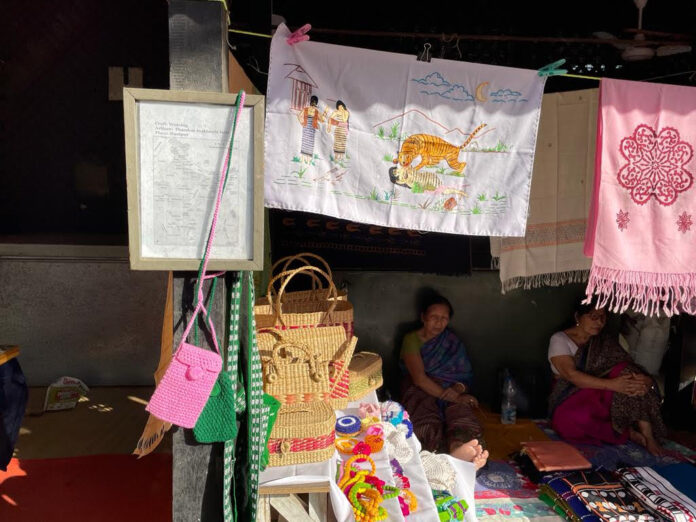Kulsoom Faiz, TwoCircles.net
Bhawar Lal, an artisan from Bikaner in Rajasthan, has long carried forward the tradition of block-printing and patchwork passed down through generations. Like many in his community, he grew up watching the women of his family stitch intricate patterns into bedspreads using fine and short threads. He witnessed, over time, how machine-made goods began to overshadow handmade crafts – gradually pushing artisans like him to the margins.
Despite the increasing dominance of fast fashion and mass production, Lal believes in the irreplaceable value of hand-crafted art. He was one of the few fortunate artisans who received a government-supported stall at the G20 summit.
Describing the journey of his art, he said, “They brought us from Bikaner to the streets of the cities. Art composed by hand is not replaceable in one’s eye. We make patchwork-embroidered bedsheets. The women of our community stitch them with short threads throughout the sheet. All this work is, however, not repaid with the advent of ‘the machine-made era’. But today, in the time of use and throw, authenticity is getting replaced because of fast fashion.”
The onset of globalisation in the 1990s and its widening impact on capitalism have transformed almost every sector, most profoundly affecting India’s marginalised artisan communities. Long celebrated for its rich artistic heritage, India now finds its traditional crafts at risk of being lost. Initiatives like the PM Vishwakarma Kaushal Samman (PM VIKAS) have registered over 21.37 lakh artisans and craftspeople, aiming to preserve and promote this heritage as a part of India’s global identity.

With the arrival of mechanisation and the increasing pace of global trade, traditional artisanal occupations have faced a steep decline.
“Mass production can lead to homogenising traditional designs and motifs, as market demand often favours standardised products. This can erode the diversity and uniqueness of regional crafts,” says Anushka Das, founder of Kalpavriksh Design and a veteran of 15 years in the textile and fashion industry.
As a key part of India’s secondary sector, government-supported textile industries provide employment to nearly 45 million people. These industries not only sustain livelihoods but also serve as a crucial support system for women and communities living in poverty.
The G20 summit in New Delhi presented a platform for India to display its deep cultural roots through traditional art. While globalisation continues to present challenges, such events offer a counterbalance – encouraging renewed appreciation for authenticity.
Handmade products today face severe competition from mass-produced alternatives. Still, artisans are now being recognised and honoured under schemes such as PM VIKAS, which identifies them as ‘Vishwakarma’ – a nod to their role as creators. This year’s Union Budget has earmarked Rs 1.48 lakh crore for education, employment and skill development, including significant support for handicrafts.
Anushka Das highlights concerns about the decline in craftsmanship. “While machines can produce items efficiently, they may not always meet the same quality standards as handmade products. Craftsmen often pay meticulous attention to detail, which can be compromised in mass production.”
Lal, too, speaks about the evolving consumer landscape shaped by fast fashion. He emphasises the enduring value of quality over cost – a principle deeply embedded in traditional craftsmanship.
Government schemes like Skill India and Make in India have helped open new doors for textile artisans. These initiatives aim to generate employment, attract investment, improve standards and replace imports with Indian-made exports. Notably, the Amended Technology Upgradation Fund Scheme (ATUFS) now receives Rs 900 crore, up from Rs 650 crore in 2022–23, to further enhance the textile industry.
Suhail Ansari, a rug maker from Mirzapur in Uttar Pradesh, has been practising his craft for over 15 years. Each year, he travels to Delhi to sell his daris at Dilli Haat, albeit for a brief 15-day window.
Unlike Lal, Ansari was not invited to present his work at G20. “Handmade is natural for us, and the value shall remain constant. People who use handmade rugs will always prefer the same, be they Indian or foreign. You will find machines made anywhere, but one will find an authentic rug in craft markets. That’s why, handmade rugs are constant,” he says.
His perspective reflects a broader truth, which is many Indian craftsmen now find international markets for their products. According to the Ministry of Textiles, 30.01% of artefact exports go to the United States, followed by 8.31% to the United Kingdom. It indicates a promising global demand.
However, Das warns that globalisation can be a double-edged sword. “While it provides access to international markets, it can also lead to a homogenisation of designs and the dilution of cultural authenticity.”
Ansari adds that despite the evolution of technology, machines cannot replicate the craftsmanship of traditional rugs. “The only hindrance that we, as the rug-making community, face is the financial adversity. Machine-made rugs are cheaper but deteriorate quickly. Authentic ones require time, skill and dedication, something no device can reproduce,” he says.

Mohammad Salim, who runs a chikan embroidery unit in Lucknow, too shares the same sentiment. Traveling to Delhi occasionally to sell his products, he insists that hand-embroidered fabric cannot be replaced. “Mass-produced chikan embroidery cannot match the perfection of handmade work,” he claims.
India’s handicraft legacy is vast and varied, shaped by its social, cultural and spiritual diversity. Sustaining this artisanal tradition in an era of modernisation is essential, not just to preserve the past but to invest in a culturally rich and economically inclusive future. Migration, often driven by financial strain, has helped blend regional styles into new hybrid forms – enriching India’s craft traditions further.
Preserving these traditions is not just a cultural responsibility, it is a blueprint for a more sustainable and inclusive India.

